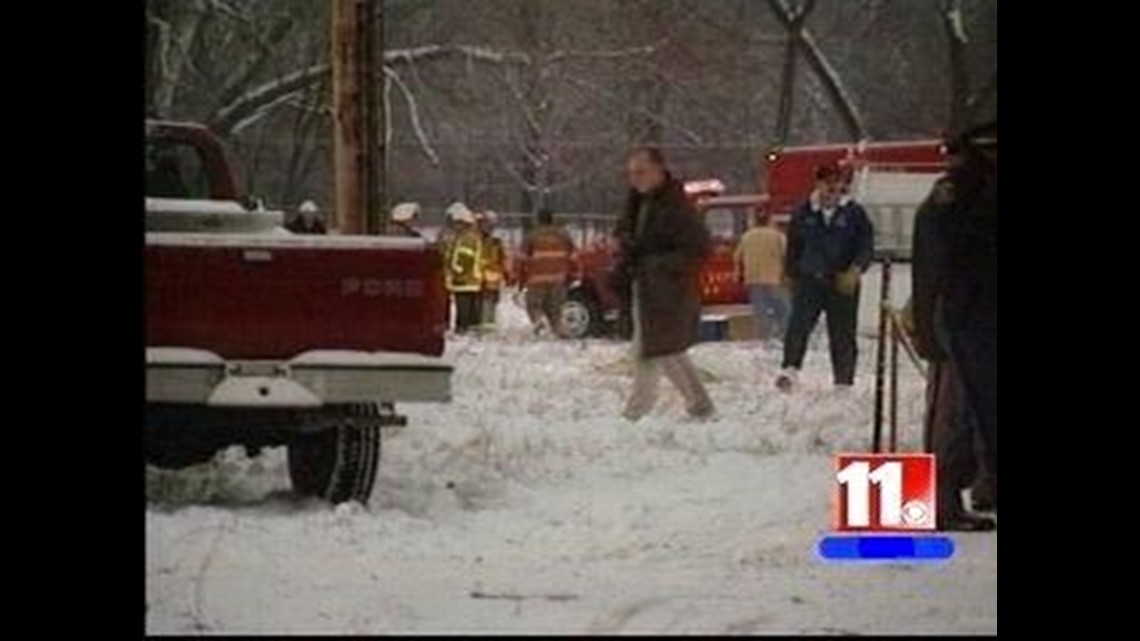

MONROE, MICHIGAN -- People observed a solemn anniversary Tuesday in a cemetery in Monroe, Michigan. It's been 10 years since Comair flight 3272 crashed into a field on a cold, snowy day, killing all 29 people on-board.
Comair 3272 crashed while on approach to the Detroit Metropolitan Wayne County Airport. The plane, an Embraer 120 twin turboprop, left the Cincinnati/Northern Kentucky International Airport about 40 minutes before it crashed. The airplane was destroyed by the impact and a post-crash fire.
The memorial service Tuesday unveiled a memorial plaque to the 26 passengers and 3 crew members who were killed in the crash. Families laid wreaths at the memorial, and also observed a moment of silence around 3:54, the time of the crash.
The two sons that Flight 3272 passenger Geoffrey Davis left behind laid their father's wreath during the service with their mom standing by. "It means a lot because today is my wedding anniversary," said Vanessa Davis. "The plane went down on our 15th wedding anniversary."
Flight 3272 was supposed to bring Geoffrey back for a celebration, but fate had other plans for him and the other 28 people on board. "A tremendous loss," Vanessa said. "It was a very, very dark time in our lives."
Families also placed roses at the memorial site. There were hugs, kisses, and tears, but somehow, some of the families found comfort among the other victims' families. "It's not the same as cancer or a car accident," said Judy Thomas, another crash victim's wife. "It's just not the same and there were no goodbyes, so these people feel the same way."
Pictures showed those who wish their loved ones were still here -- the dads, the husbands, the children. "There isn't a day that goes by. He's my son," said Arlene Miasel. Her son was the pilot of Flight 3272.
Geoffrey's family remembers him every day, and are grateful they knew him. "We really appreciate the fact that he was born into the world and how many lives he did touch," said Patricia Lighten, Geoffrey's sister.
"He was just a great husband and father," said Davis.
The families of the victims weren't the only ones affected by the crash. Volunteer firefighter Paul Metz responded within 10 minutes of the first call in 1997. "I could probably take you to that scene right now, and point out where the plane crashed, where victims were laying," Metz said, adding that it took just moments to realize all 29 people on board were dead. "It went from a rescue situation to a very silent and quiet mode."
Captain Marvin Hicks spent weeks helping his colleagues cope in the aftermath of the crash. "They were walking around with no expression," he said.
Metz said he was tremendously affected by the incident. "I can almost relate to anyone whose been in war, Vietnam vet, who had to watch people blow up," he said.
According to the official report on the crash from the National Transportation Safety Board, investigators think flight 3272 gradually accumulated a thin, rough glaze of ice on its wings as the plane descended toward Detroit. Investigators think that caused the plane's performance to suffer, which may have been imperceptible to the pilots.
The report says the pilots had been instructed by air traffic control to slow to 150 knots and according to flight data recorder information, they lost control of the airplane as its speed dropped below 155 knots. Investigators think the ice caused the wings to lose lift, and the airplane rolled out of control before crashing nose-down into the field.
The death count was 29, but for those who knew them, the people on flight 3272 were more than just names on a list. Passengers on the plane were from all parts of America, including a mother and infant who were going to visit a grandparent for the first time, a student coming back from a job interview, several executives flying on business, a woman going to her brother's funeral, and a man rushing to the bedside of his father, who was about to have open-heart surgery.
The pilots were considered two of Comair's best and brightest, and the flight attendant was known for her love of flying.
In its official report adopted in 1998, The National Transportation Safety Board blamed the Federal Aviation Administration for not establishing standards for flight in weather conditions that may cause ice to build up on airplanes. The NTSB also blamed the flight crew for making poor decisions while flying into conditions where ice may accumulate, and not keeping the speed of the airplane up. It blamed Comair for not establishing standards for flight into icing conditions.
As a result of the crash, the National Transportation Safety Board issued 4 safety recommendations to the FAA regarding flights by the Embraer 120 into ice conditions. Those recommendations in May of 1997 covered minimum airspeed information, ice protection system operational procedures, and ice detection/warning systems.

